Yamaha XCITY250 Manual
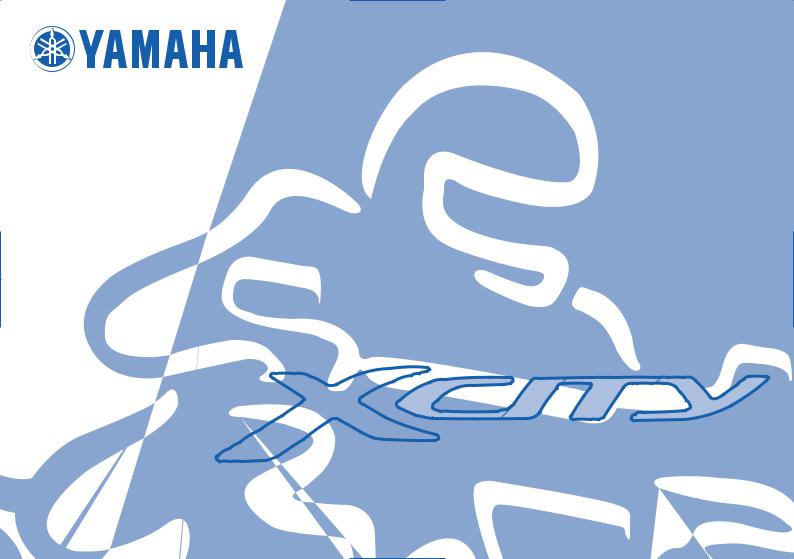
OWNER’S MANUAL
VP250
5B2-F8199-E0


INTRODUCTION
EAU10110
Welcome to the Yamaha world of motorcycling!
As the owner of the VP250, you are benefiting from Yamaha’s vast experience and newest technology regarding the design and manufacture of high-quality products, which have earned Yamaha a reputation for dependability.
Please take the time to read this manual thoroughly, so as to enjoy all advantages of your VP250. The owner’s manual does not only instruct you in how to operate, inspect and maintain your scooter, but also in how to safeguard yourself and others from trouble and injury.
In addition, the many tips given in this manual will help keep your scooter in the best possible condition. If you have any further questions, do not hesitate to contact your Yamaha dealer.
The Yamaha team wishes you many safe and pleasant rides. So, remember to put safety first!
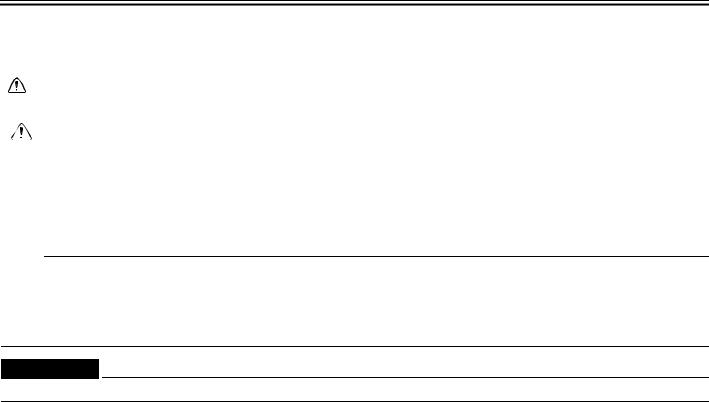
IMPORTANT MANUAL INFORMATION
EAU34111
Particularly important information is distinguished in this manual by the following notations:
|
|
|
|
The Safety Alert Symbol means ATTENTION! BECOME ALERT! YOUR SAFETY IS |
|
|
|
|
INVOLVED! |
|
|
|
|
|
|
|
|
|
|
|
|
|
|
Failure to follow WARNING instructions could result in severe injury or death to the |
|
WARNING |
|
||
|
|
scooter operator, a bystander, or a person inspecting or repairing the scooter. |
||
|
|
|
|
|
|
|
|
|
|
|
|
|
|
|
|
|
|
|
A CAUTION indicates special precautions that must be taken to avoid damage to |
|
CAUTION: |
|
|
|
|
|
the scooter. |
||
|
|
|
|
|
|
|
|
|
|
NOTE: |
A NOTE provides key information to make procedures easier or clearer. |
|
|
NOTE:
●This manual should be considered a permanent part of this scooter and should remain with it even if the scooter is subsequently sold.
●Yamaha continually seeks advancements in product design and quality. Therefore, while this manual contains the most current product information available at the time of printing, there may be minor discrepancies between your scooter and this manual. If you have any questions concerning this manual, please consult your Yamaha dealer.
EWA12410
 WARNING
WARNING
PLEASE READ THIS MANUAL CAREFULLY AND COMPLETELY BEFORE OPERATING THIS SCOOTER.
*Product and specifications are subject to change without notice.
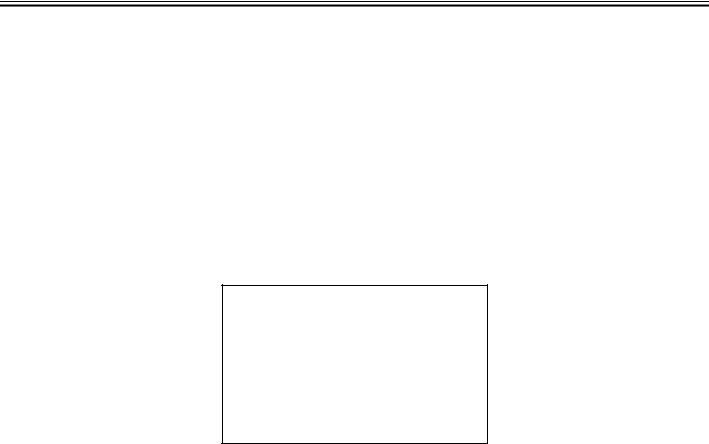
IMPORTANT MANUAL INFORMATION
EAUM1010
VP250
OWNER’S MANUAL ©2007 by MBK INDUSTRIE 1st edition, January 2007 All rights reserved
Any reprinting or unauthorized use without the written permission of MBK INDUSTRIE
is expressly prohibited. Printed in France.

TABLE OF CONTENTS
SAFETY INFORMATION .................. |
1-1 |
Further safe-riding points ................ |
1-4 |
DESCRIPTION .................................. |
2-1 |
Left view .......................................... |
2-1 |
Right view ........................................ |
2-2 |
Controls and instruments................. |
2-3 |
INSTRUMENT AND CONTROL |
|
FUNCTIONS ....................................... |
3-1 |
Main switch/steering lock ................ |
3-1 |
Indicator and warning lights ............ |
3-2 |
Speedometer .................................. |
3-2 |
Fuel gauge ...................................... |
3-3 |
Coolant temperature gauge ............ |
3-3 |
Multi-function display ...................... |
3-3 |
Handlebar switches ........................ |
3-6 |
Front brake lever ............................ |
3-7 |
Rear brake lever ............................. |
3-8 |
Fuel tank cap .................................. |
3-8 |
Fuel ................................................. |
3-8 |
Catalytic converter .......................... |
3-9 |
Seat .............................................. |
3-10 |
Storage compartment ................... |
3-10 |
Storage compartment ................... |
3-11 |
Adjusting the shock absorber |
|
assemblies ................................ |
3-12 |
Luggage hook ............................... |
3-12 |
Sidestand ...................................... |
3-13 |
Ignition circuit cut-off system ........ |
3-13 |
PRE-OPERATION CHECKS ............. |
4-1 |
Pre-operation check list .................. |
4-2 |
OPERATION AND IMPORTANT |
|
RIDING POINTS................................. |
5-1 |
Starting the engine ......................... |
5-1 |
Starting off ...................................... |
5-2 |
Acceleration and deceleration ........ |
5-2 |
Braking ........................................... |
5-2 |
Tips for reducing fuel |
|
consumption ............................... |
5-3 |
Engine break-in .............................. |
5-3 |
Parking ........................................... |
5-4 |
PERIODIC MAINTENANCE AND |
|
MINOR REPAIR ................................. |
6-1 |
Owner’s tool kit ............................... |
6-1 |
Periodic maintenance and |
|
lubrication chart .......................... |
6-2 |
Removing and installing cowlings |
|
and panels .................................. |
6-5 |
Checking the spark plug ................. |
6-6 |
Engine oil ....................................... |
6-7 |
Final transmission oil ...................... |
6-9 |
Coolant ......................................... |
6-10 |
Air filter and V-belt case air filter |
|
elements ................................... |
6-11 |
Checking the throttle cable free |
|
play ........................................... |
6-12 |
Valve clearance ............................ |
6-13 |
Tires ............................................. |
6-13 |
Cast wheels ................................. |
6-15 |
Front and rear brake lever free |
|
play ........................................... |
6-15 |
Checking the front and rear brake |
|
pads .......................................... |
6-16 |
Checking the brake fluid level ...... |
6-16 |
Changing the brake fluid .............. |
6-17 |
Checking and lubricating the |
|
cables ....................................... |
6-18 |
Checking and lubricating the |
|
throttle grip and cable ............... |
6-18 |
Lubricating the front and rear |
|
brake levers .............................. |
6-18 |
Checking and lubricating the |
|
centerstand and sidestand ....... |
6-19 |
Checking the front fork ................. |
6-19 |
Checking the steering .................. |
6-20 |
Checking the wheel bearings ....... |
6-21 |
Battery ......................................... |
6-21 |
Replacing the fuses ..................... |
6-22 |
Replacing a headlight bulb .......... |
6-23 |
Replacing a front turn signal light |
|
bulb ........................................... |
6-25 |
Replacing a tail/brake light bulb or |
|
a rear turn signal light bulb ....... |
6-26 |
Replacing the license plate light |
|
bulb ........................................... |
6-27 |
Replacing an auxiliary light |
|
bulb ........................................... |
6-27 |
Troubleshooting ........................... |
6-27 |
Troubleshooting charts ................ |
6-28 |

TABLE OF CONTENTS
SCOOTER CARE AND STORAGE ... |
7-1 |
Care ................................................ |
7-1 |
Storage ........................................... |
7-3 |
SPECIFICATIONS ............................. |
8-1 |
CONSUMER INFORMATION............. |
9-1 |
Identification numbers .................... |
9-1 |

 SAFETY INFORMATION
SAFETY INFORMATION
EAU10261
SCOOTERS ARE SINGLE TRACK
1VEHICLES. THEIR SAFE USE AND OPERATION ARE DEPENDENT UPON THE USE OF PROPER RIDING TECHNIQUES AS WELL AS THE EXPERTISE OF THE OPERATOR. EVERY OPERATOR SHOULD KNOW THE FOLLOWING REQUIREMENTS BEFORE RIDING THIS SCOOTER.
HE OR SHE SHOULD:
●OBTAIN THOROUGH INSTRUCTIONS FROM A COMPETENT SOURCE ON ALL ASPECTS OF SCOOTER OPERATION.
●OBSERVE THE WARNINGS AND MAINTENANCE REQUIREMENTS IN THE OWNER’S MANUAL.
●OBTAIN QUALIFIED TRAINING IN SAFE AND PROPER RIDING TECHNIQUES.
●OBTAIN PROFESSIONAL TECHNICAL SERVICE AS INDICATED BY THE OWNER’S MANUAL AND/OR WHEN MADE NECESSARY BY MECHANICAL CONDITIONS.
Safe riding
●Always make pre-operation checks. Careful checks may help prevent an accident.
●This scooter is designed to carry the operator and passenger.
●The failure of motorists to detect and recognize scooters in traffic is the predominating cause of automobile/scooter accidents. Many accidents have been caused by an automobile driver who did not see the scooter. Making yourself conspicuous appears to be very effective in reducing the chance of this type of accident.
Therefore:
•Wear a brightly colored jacket.
•Use extra caution when approaching and passing through intersections, since intersections are the most likely places for scooter accidents to occur.
•Ride where other motorists can see you. Avoid riding in another motorist’s blind spot.
●Many accidents involve inexperienced operators. In fact, many operators who have been involved in accidents do not even have a current driver’s license.
•Make sure that you are qualified and that you only lend your scooter to other qualified operators.
•Know your skills and limits. Staying within your limits may help you to avoid an accident.
•We recommend that you practice riding your scooter where there is no traffic until you have become thoroughly familiar with the scooter and all of its controls.
●Many accidents have been caused by error of the scooter operator. A typical error made by the operator is veering wide on a turn due to EXCESSIVE SPEED or undercornering (insufficient lean angle for the speed).
•Always obey the speed limit and never travel faster than warranted by road and traffic conditions.
1-1

 SAFETY INFORMATION
SAFETY INFORMATION
•Always signal before turning or changing lanes. Make sure that other motorists can see you.
●The posture of the operator and passenger is important for proper control.
•The operator should keep both hands on the handlebar and both feet on the footboard during operation to maintain control of the scooter.
•The passenger should always hold onto the operator, the seat strap or grab bar, if equipped, with both hands and keep both feet on the passenger footrests.
•Never carry a passenger unless he or she can firmly place both feet on the passenger footrests.
●Never ride under the influence of alcohol or other drugs.
●This scooter is designed for onroad use only. It is not suitable for off-road use.
Protective apparel
The majority of fatalities from scooter accidents are the result of head injuries. The use of a safety helmet is the single most critical factor in the prevention or reduction of head injuries.
●Always wear an approved helmet.
●Wear a face shield or goggles. Wind in your unprotected eyes could contribute to an impairment of vision which could delay seeing a hazard.
●The use of a jacket, substantial shoes, trousers, gloves, etc., is effective in preventing or reducing abrasions or lacerations.
●Never wear loose-fitting clothes, otherwise they could catch on the control levers or wheels and cause injury or an accident.
●Never touch the engine or exhaust system during or after operation. They become very hot and can cause burns. Always wear protective clothing that covers your legs, ankles, and feet.
●Passengers should also observe the above precautions.
Modifications
Modifications made to this scooter not approved by Yamaha, or the removal of original equipment, may render the 1 scooter unsafe for use and may cause severe personal injury. Modifications may also make your scooter illegal to use.
Loading and accessories
Adding accessories or cargo to your scooter can adversely affect stability and handling if the weight distribution of the scooter is changed. To avoid the possibility of an accident, use extreme caution when adding cargo or accessories to your scooter. Use extra care when riding a scooter that has added cargo or accessories. Here are some general guidelines to follow if loading cargo or adding accessories to your scooter:
Loading
The total weight of the operator, passenger, accessories and cargo must not exceed the maximum load limit.
Maximum load:
185 kg (408 lb)
1-2

 SAFETY INFORMATION
SAFETY INFORMATION
When loading within this weight limit, keep the following in mind:
● Cargo and accessory weight
1should be kept as low and close to the scooter as possible. Make sure to distribute the weight as evenly as possible on both sides of the scooter to minimize imbalance or instability.
●Shifting weights can create a sudden imbalance. Make sure that accessories and cargo are securely attached to the scooter before riding. Check accessory mounts and cargo restraints frequently.
●Never attach any large or heavy items to the handlebar, front fork, or front fender. Such items can create unstable handling or a slow
steering response. Accessories
Genuine Yamaha accessories have been specifically designed for use on this scooter. Since Yamaha cannot test all other accessories that may be available, you must personally be responsible for the proper selection, installation
and use of non-Yamaha accessories. Use extreme caution when selecting and installing any accessories.
Keep the following guidelines in mind, as well as those provided under “Loading” when mounting accessories.
●Never install accessories or carry cargo that would impair the performance of your scooter. Carefully inspect the accessory before using it to make sure that it does not in any way reduce ground clearance or cornering clearance, limit suspension travel, steering travel or control operation, or obscure lights or reflectors.
•Accessories fitted to the handlebar or the front fork area can create instability due to improper weight distribution or aerodynamic changes. If accessories are added to the handlebar or front fork area, they must be as lightweight as possible and should be kept to a minimum.
•Bulky or large accessories may seriously affect the stability of the scooter due to aerodynamic effects. Wind may attempt to lift
1-3
the scooter, or the scooter may become unstable in cross winds. These accessories may also cause instability when passing or being passed by large vehicles.
•Certain accessories can displace the operator from his or her normal riding position. This improper position limits the freedom of movement of the operator and may limit control ability, therefore, such accessories are not recommended.
●Use caution when adding electrical accessories. If electrical accessories exceed the capacity of the scooter’s electrical system an electric failure could result, which could cause a dangerous loss of lights or engine power.
Gasoline and exhaust gas
●GASOLINE IS HIGHLY FLAMMABLE:
•Always turn the engine off when refueling.

 SAFETY INFORMATION
SAFETY INFORMATION
•Take care not to spill any gasoline on the engine or exhaust system when refueling.
•Never refuel while smoking or in the vicinity of an open flame.
●Never start the engine or let it run for any length of time in a closed area. The exhaust fumes are poisonous and may cause loss of consciousness and death within a short time. Always operate your scooter in an area that has adequate ventilation.
●Always turn the engine off before leaving the scooter unattended and remove the key from the main switch. When parking the scooter, note the following:
•The engine and exhaust system may be hot, therefore, park the scooter in a place where pedestrians or children are not likely to touch these hot areas.
•Do not park the scooter on a slope or soft ground, otherwise it may fall over.
•Do not park the scooter near a flammable source (e.g., a kerosene heater, or near an open flame), otherwise it could catch fire.
●If you should swallow any gasoline, inhale a lot of gasoline vapor, or allow gasoline to get into your eyes, see your doctor immediately. If any gasoline spills on your skin or clothing, immediately wash the affected area with soap and water and change your clothes.
EAU10371 |
|
Further safe-riding points |
|
● Be sure to signal clearly when |
|
making turns. |
1 |
●Braking can be extremely difficult on a wet road. Avoid hard braking, because the scooter could slide. Apply the brakes slowly when stopping on a wet surface.
●Slow down as you approach a corner or turn. Once you have completed a turn, accelerate slowly.
●Be careful when passing parked cars. A driver might not see you and open a door in your path.
●Railroad crossings, streetcar rails, iron plates on road construction sites, and manhole covers become extremely slippery when wet. Slow down and cross them with caution. Keep the scooter upright, otherwise it could slide out from under you.
●The brake pads could get wet when you wash the scooter. After washing the scooter, check the brakes before riding.
1-4

 SAFETY INFORMATION
SAFETY INFORMATION
●Always wear a helmet, gloves, trousers (tapered around the cuff and ankle so they do not flap), and
1a bright colored jacket.
●Do not carry too much luggage on the scooter. An overloaded scooter is unstable.
1-5
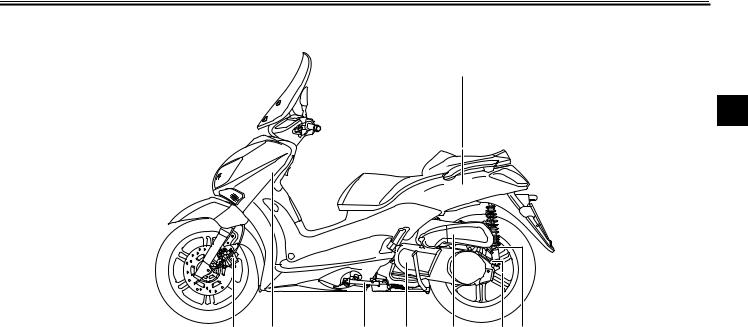
DESCRIPTION
EAU10410
Left view
1
2
8 |
7 |
6 |
5 |
4 |
3 |
2 |
1.Rear storage compartment (page 3-11)
2.Shock absorber assembly spring preload adjusting ring (page 3-12)
3.Final transmission oil filler cap (page 6-9)
4.Air filter element (page 6-11)
5.V-belt case air filter element (page 6-11)
6.Sidestand (page 3-13, 6-19)
7.Coolant level check window (page 6-10)
8.Front brake pads (page 6-16)
2-1
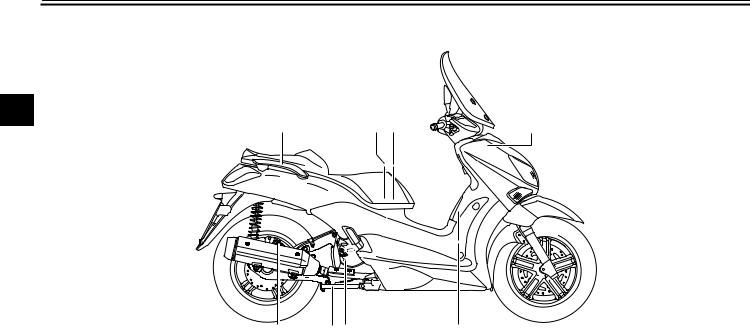
DESCRIPTION
EAU10420
Right view
2
1 |
2 |
3 |
4 |
8 |
7 6 |
5 |
1.Grab bar (page 5-2)
2.Main fuse/fuse box (page 6-22)
3.Battery (page 6-21)
4.Coolant reservoir cap (page 6-10)
5.Fuel tank cap (page 3-8)
6.Engine oil filler cap (page 6-7)
7.Centerstand (page 6-19)
8.Rear brake pads (page 6-16)
2-2
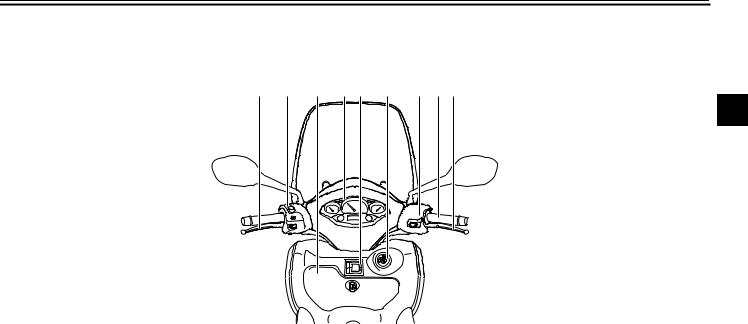
DESCRIPTION
EAU10430
Controls and instruments
1 |
2 |
3 |
4 5 |
6 |
7 |
8 9 |
2
1. Rear brake lever (page 3-8) |
9. Front brake lever (page 3-7) |
2.Left handlebar switches (page 3-6)
3.Front storage compartment (page 3-10)
4.Speedometer/Multi-function display (page 3-2/page 3-3)
5.Luggage hook (page 3-12)
6.Main switch/steering lock (page 3-1)
7.Right handlebar switch (page 3-6)
8.Throttle grip (page 6-12)
2-3

INSTRUMENT AND CONTROL FUNCTIONS
EAU10460
Main switch/steering lock
OPEN
PUSH
3
ZAUM0253
The main switch/steering lock controls the ignition and lighting systems, and is used to lock the steering. The various positions are described below.
EAU34121
ON “ ”
”
All electrical circuits are supplied with power; the meter lighting, taillight, license plate light and auxiliary lights come on, and the engine can be started. The key cannot be removed.
NOTE:
The headlights come on automatically when the engine is started and stay on until the key is turned to “ ” or the sidestand is moved down.
” or the sidestand is moved down.
EAU10660
OFF “ ”
”
All electrical systems are off. The key can be removed.
EAU10680
LOCK “  ”
”
The steering is locked, and all electrical systems are off. The key can be removed.
To lock the steering
1.Turn the handlebars all the way to the left.
2.Push the key in from the “ ” position, and then turn it to “
” position, and then turn it to “ ” while still pushing it.
” while still pushing it.
3.Remove the key.
To unlock the steering
Push the key in, and then turn it to “ ” while still pushing it.
” while still pushing it.
EWA10060
 WARNING
WARNING
Never turn the key to “ ” or “
” or “ ” while the vehicle is moving, otherwise the electrical systems will be switched off, which may result in
” while the vehicle is moving, otherwise the electrical systems will be switched off, which may result in
loss of control or an accident. Make sure that the vehicle is stopped before turning the key to “ ” or “
” or “ ”.
”.
3-1

INSTRUMENT AND CONTROL FUNCTIONS
EAU11003
Indicator and warning lights
1 2 |
3 4 |
ZAUM0635
1.High beam indicator light “  ”
”
2.Left turn signal indicator light “ ”
”
3.Right turn signal indicator light “ ”
”
4.Engine trouble warning light “  ”
”
EAU11030
Turn signal indicator lights “ ” and
” and
“ ”
”
The corresponding indicator light flashes when the turn signal switch is pushed to the left or right.
EAU11480
Engine trouble warning light “  ”
”
This warning light comes on when an electrical circuit monitoring the engine is defective. When this occurs, have a Yamaha dealer check the self-diagno- sis system.
The electrical circuit of the warning light can be checked by turning the key to “ ”. If the warning light does not come on for a few seconds, then go off, have a Yamaha dealer check the electrical circuit.
”. If the warning light does not come on for a few seconds, then go off, have a Yamaha dealer check the electrical circuit.
EAU11591
Speedometer
1
3
ZAUM0636
1. Speedometer
UK ONLY
1
40 mph50 |
60 |
30 |
70 |
20 



 80
80
 10
10 

 90
90
 0 100
0 100
ZAUM0637
EAU11080
High beam indicator light “ ”
”
This indicator light comes on when the high beam of the headlight is switched on.
1. Speedometer
The speedometer shows the riding speed.
3-2
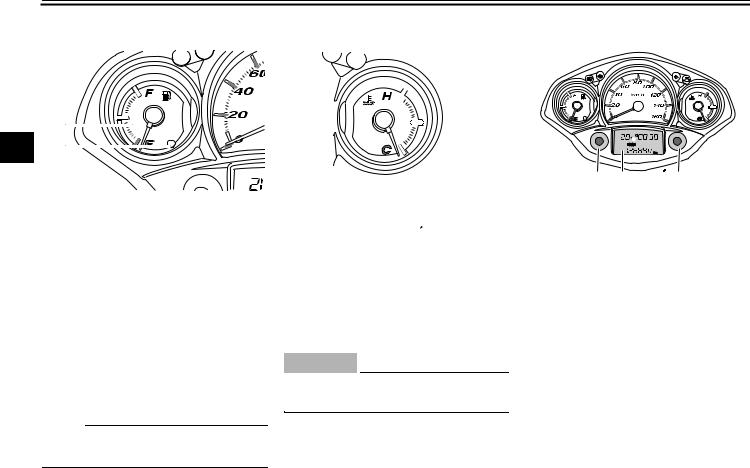
INSTRUMENT AND CONTROL FUNCTIONS
EAUM1470
Fuel gauge
1
3 2
ZAUM0638
1.Fuel gauge
2.Fuel level warning light
The fuel gauge indicates the amount of fuel in the fuel tank. The needle moves towards “E” (Empty) as the fuel level decreases. When the remaining fuel in the tank reaches approximately 2.7 L (0.72 US gal) (0.60 Imp.gal), the fuel level warning light will come on and the multi-function display will automatically change to the “Trip/fuel” mode. (See page 3-3.) If this occurs, refuel as soon as possible.
NOTE:
Do not allow the fuel tank to empty itself completely.
EAU12171
Coolant temperature gauge
 1
1
ZAUM0639
1. Red zone
With the key in the “ ” position, the coolant temperature gauge indicates the temperature of the coolant. The coolant temperature varies with changes in the weather and engine load. If the needle reaches or enters the red zone, stop the vehicle and let the engine cool. (See page 6-28.)
” position, the coolant temperature gauge indicates the temperature of the coolant. The coolant temperature varies with changes in the weather and engine load. If the needle reaches or enters the red zone, stop the vehicle and let the engine cool. (See page 6-28.)
ECA10020
CAUTION:
Do not operate the engine if it is overheated.
EAUM2050
Multi-function display
|
|
|
|
|
|
|
|
|
|
|
|
|
|
|
|
|
|
|
|
|
ZAUM0640 |
1 2 |
3 |
|
|||
1.“MODE” button
2.Multi-function display
3.“SET” button
The multi-function display is equipped with the following:
●an odometer (which shows the total distance traveled)
●two tripmeters (which show the distance traveled since they were last set to zero, the time passed since the tripmeters were set to zero, and the average speed traveled during this time)
●a fuel reserve tripmeter (which shows the distance traveled since the fuel level warning light came on)
3-3
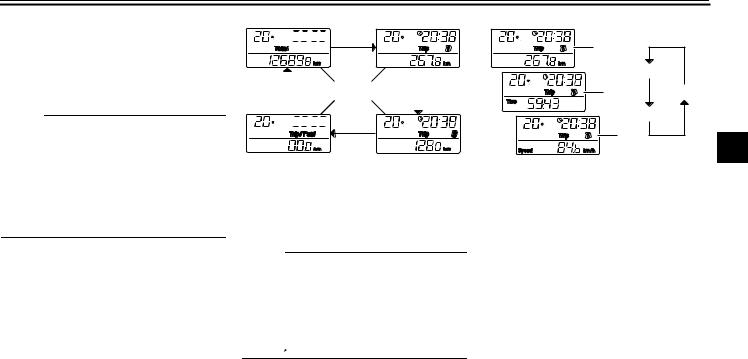
INSTRUMENT AND CONTROL FUNCTIONS
●a clock
●an ambient temperature display
●an oil change indicator (which comes on when the engine oil should be changed)
NOTE:
●For the UK, the distance traveled is displayed in miles and the temperature reading is displayed in °F.
●For other countries, the distance traveled is displayed in kilometers and the temperature reading is displayed in °C.
Odometer and tripmeter modes
Pushing the “MODE” button switches the display between the odometer mode “Total” and the tripmeter modes “Trip” in the following order:
Total → Trip 1 → Trip 2 → Trip/fuel → Total




 "Mode"
"Mode"
|
|
1 |
2 |
|
|
|
"Mode" |
"Mode" |
|||||
4 |
3 |
|||||
|
|
|
|
|||
|
|
|
|
|
|
|




 "Mode"
"Mode"
ZAUM0391
1.Total
2.Trip 1
3.Trip 2
4.Trip/Fuel
NOTE:
●The Trip/fuel odometer is only activated if the fuel level warning light comes on.
●The Trip 2 odometer is automatically reset after turning the key to “ ” and two hours have passed.
” and two hours have passed.
Pushing the “SET” button when in the tripmeter mode switches the display between the different tripmeter functions in the following order:
Trip 1 or Trip 2 → Time 1 or 2 → Average speed 1 or 2 → Trip 1 or Trip 2
1
"Set"
2 "Set"
"Set"
3
3
ZAUM0392
1.Distance
2.Time
3.Average speed
If the fuel level warning light comes on (See page 3-3.), the display will automatically change to the fuel reserve tripmeter mode “Trip/fuel” and start counting the distance traveled from that point. In that case, pushing the “MODE” button switches the display between the various tripmeter and odometer modes in the following order:
Trip/Fuel → Trip 1 → Trip 2 → Total → Trip/fuel
3-4
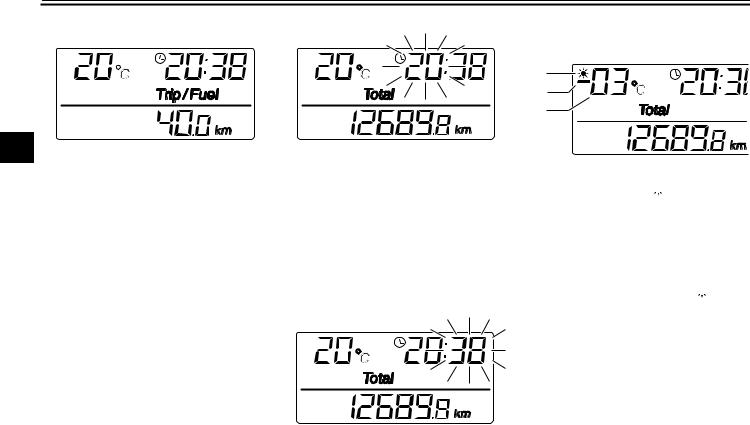
INSTRUMENT AND CONTROL FUNCTIONS
3
ZAUM0393
To reset a tripmeter, select it by pushing the “MODE” button, and then push the “SET” button for at least one second. If you do not reset the fuel reserve tripmeter manually, it will reset itself automatically and the display will return to the prior mode after refueling and traveling 5 km (3 mi).
Clock mode
To set the clock:
1.When the display is in the “Total” mode, push the “SET” button for at least two seconds.
2.When the hour digits start flashing, push the “SET” button to set the hours.
ZAUM0394
3.Push the “MODE” button, and the minute digits will start flashing.
4.Push the “SET” button to set the minutes.
5.Push the “MODE” button and then release it to start the clock. The display will return to the “Total” mode.
ZAUM0395
Ambient temperature display
1
2
3
ZAUM0396
1.Frost warning indicator “
 ”
”
2.Minus item
3.Temperature
This display shows the ambient temperature from –30 °C (–86 °F) to 50 °C (122 °F).
The frost warning indicator “
 ” automatically comes on if the temperature is lower than 3 °C (37.4 °F).
” automatically comes on if the temperature is lower than 3 °C (37.4 °F).
3-5

INSTRUMENT AND CONTROL FUNCTIONS
Oil change indicator “OIL”
1
ZAUM0582
1. Oil change indicator “OIL”
The engine oil should be changed when this indicator comes on. The indicator stays on until it is reset. After changing the engine oil, reset the indicator as follows.
1.While holding the “MODE” and “SET” buttons pushed, turn the key to “ ”.
”.
2.Continue holding the “MODE” and “SET” buttons pushed for two to five seconds.
3.Release the buttons and the oil change indicator will go off.
NOTE:
●The oil change indicator will come on at the initial 1000 km (600 mi) and every 3000 km (4800 mi) thereafter.
●If the engine oil is changed before the oil change indicator comes on (i.e. before the periodic oil change interval has been reached), the indicator must be reset after the oil change for the next periodic oil change to be indicated at the correct time. After resetting, the indicator will come on for two seconds. If the indicator does not come on, repeat the procedure.
EAU12347
Handlebar switches
Left
3
1.Dimmer “  /
/ ”/Pass “
”/Pass “  ” switch
” switch
2.Turn signal switch “ /
/ ”
”
3.Horn switch “  ”
”
Right
1
ZAUM0642
1. Start switch “ ”
”
3-6
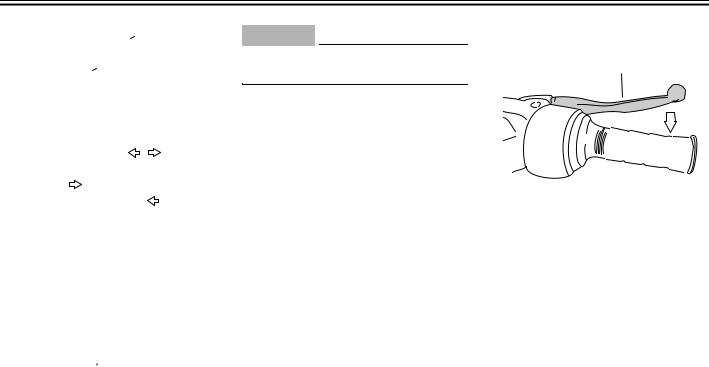
INSTRUMENT AND CONTROL FUNCTIONS
EAUS1020
Dimmer switch “ /
/ ”
”
Set this switch to “ ” for the high beam and to “
” for the high beam and to “ ” for the low beam. With the headlight on low beam, press this switch downwards to flash the headlight.
” for the low beam. With the headlight on low beam, press this switch downwards to flash the headlight.
|
3 |
|
|
EAU12460 |
|
|
Turn signal switch “ / |
” |
|
|
|
|
||
|
|
|
To signal a right-hand turn, push this |
|
|
|
|
||
|
|
|
switch to “ ”. To signal a left-hand |
|
|
|
|
turn, push this switch to “ |
”. When re- |
leased, the switch returns to the center position. To cancel the turn signal lights, push the switch in after it has returned to the center position.
ECA10050
CAUTION:
See page 5-1 for starting instructions prior to starting the engine.
EAU12900
Front brake lever
1
ZAUM0084
1. Front brake lever
The front brake lever is located on the right handlebar grip. To apply the front brake, pull this lever toward the handlebar grip.
EAU12500
Horn switch “  ”
”
Press this switch to sound the horn.
EAU12720
Start switch “ ”
”
With the sidestand up, push this switch while applying the front or rear brake to crank the engine with the starter.
3-7
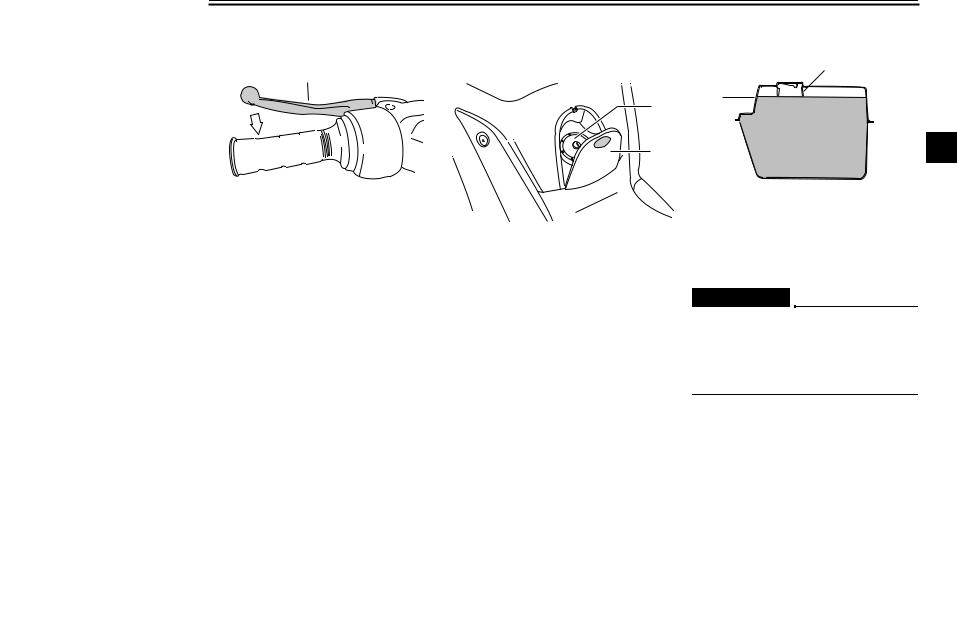
INSTRUMENT AND CONTROL FUNCTIONS
EAU12950
Rear brake lever
1
ZAUM0085
1. Rear brake lever
The rear brake lever is located on the left handlebar grip. To apply the rear brake, pull this lever toward the handlebar grip.
EAUM2160
Fuel tank cap
To open the fuel tank cap
1
2
ZAUM0643
1.Fuel tank cap
2.Fuel tank cap cover
1.Open the fuel tank cap cover by pushing in on the front end of it.
2.Insert the key in the lock and turn it clockwise.
To close the fuel tank cap
1.Align the match marks, and then push the fuel tank cap into the original position.
2.Turn the key counterclockwise and remove it.
3.Close the fuel tank cover.
EAU13211
Fuel
1
2
3
ZAUM0020
1.Fuel tank filler tube
2.Fuel level
Make sure that there is sufficient fuel in the tank. Fill the fuel tank to the bottom of the filler tube as shown.
EWA10880
 WARNING
WARNING
●Do not overfill the fuel tank, otherwise it may overflow when the fuel warms up and expands.
●Avoid spilling fuel on the hot engine.
3-8
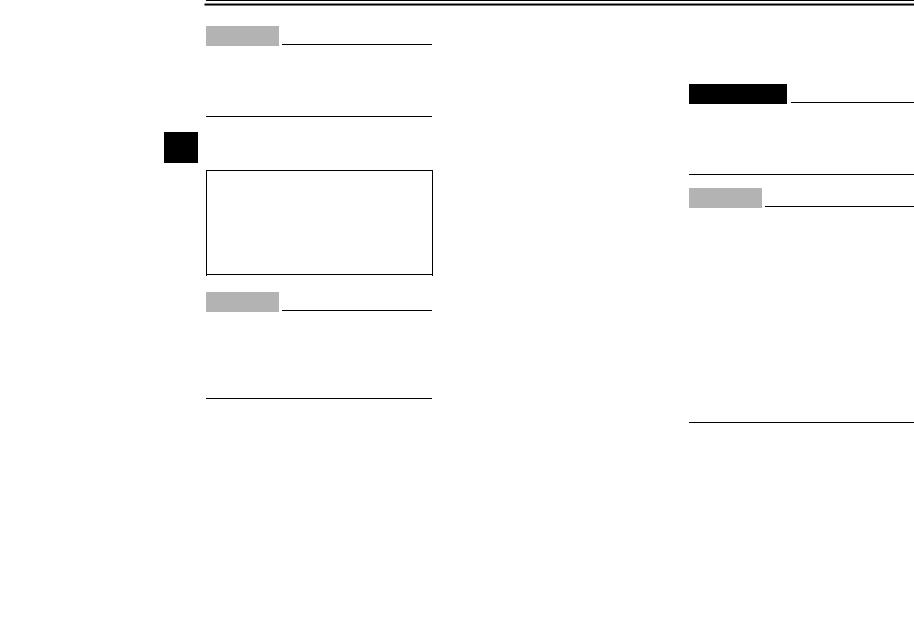
INSTRUMENT AND CONTROL FUNCTIONS
ECA10070
CAUTION:
Immediately wipe off spilled fuel with a clean, dry, soft cloth, since fuel may deteriorate painted surfaces or plastic parts.
EAU13320
3
Recommended fuel:
REGULAR UNLEADED GASOLINE ONLY
Fuel tank capacity:
10.5 L (2.77 US gal) (2.31 Imp.gal)
Fuel reserve amount:
2.7 L (0.72 US gal) (0.60 Imp.gal)
ECA11400
CAUTION:
Use only unleaded gasoline. The use of leaded gasoline will cause severe damage to internal engine parts, such as the valves and piston rings, as well as to the exhaust system.
Your Yamaha engine has been designed to use regular unleaded gasoline with a research octane number of 91 or higher. If knocking (or pinging) occurs, use a gasoline of a different brand
or premium unleaded fuel. Use of unleaded fuel will extend spark plug life and reduce maintenance costs.
EAU13441
Catalytic converter
This vehicle is equipped with catalytic converters in the exhaust system.
EWA10860
 WARNING
WARNING
The exhaust system is hot after operation. Make sure that the exhaust system has cooled down before doing any maintenance work.
ECA10700
CAUTION:
The following precautions must be observed to prevent a fire hazard or other damages.
●Use only unleaded gasoline. The use of leaded gasoline will cause unrepairable damage to the catalytic converter.
●Never park the vehicle near possible fire hazards such as grass or other materials that easily burn.
●Do not allow the engine to idle too long.
3-9
